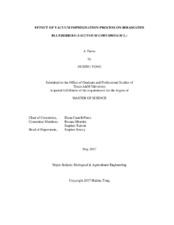| dc.description.abstract | Blueberries have many health benefits such as high content of anthocyanins, phenols and other antioxidants, which could prevent cancer and cardiovascular diseases. However, the texture of blueberries can easily deteriorate during handling, processing and distribution, which leads to food loss. This is a particular problem when blueberries are irradiated as a treatment for food safety purposes.
This research evaluated the effects of vacuum impregnation on the texture and quality of irradiated blueberries. Moisture content, texture, color, total soluble solids, pH, total titratable acidity, and total phenol amount were evaluated on Day 0 (the day of the treatment), Day 7, and Day 14 of storage at 4.5-5ºC, 50-55%RH. A consumer test was also conducted.
Fresh blueberries were vacuum impregnated with calcium lactate solution at 4%, 5%, and 6% concentration (w/w). Results showed that under 160 mm Hg bar pressure and 8% solid-liquid ratio (blueberries-impregnation solution), the 4% calcium lactate solution with two-step vacuum impregnation process yielded blueberries with firmer (P<0.05) texture. Blueberries were initially exposed to vacuum for 5 mins followed by 5 mins at atmospheric conditions. A second step consisted of 10 mins vacuum followed by 10 mins at atmospheric conditions. Overall, vacuum impregnation treatment did not affect (P>0.05) moisture content, pH or other quality attributes and consumers equally liked vacuum impregnated blueberries and the fresh samples.
On a second study, blueberries impregnated with 4% calcium lactate solution were irradiated using a 1.35 MeV electron beam irradiator. The irradiation doses tested ranged from 0.0 kGy (control) to 2.0 kGy. Irradiation did not (P>0.05) affect the pH or total phenolic amount of blueberries. Although vacuum impregnated blueberries were firmer (P<0.05) than non-VI treated blueberries under the same irradiation dosage, fruit firmness was affected (P<0.05) by exposure to the electron beams. This negative effect was more significant at higher dose levels. On the other hand, when exposed to the maximum allowed dose for fresh produce (1.0 kGy), vacuum impregnation helped maintain the texture of the blueberries (P>0.05) throughout the refrigerated storage while the controls showed considerable softness. | en |


